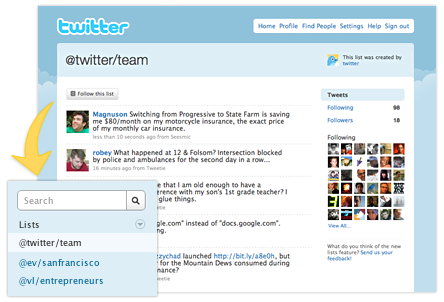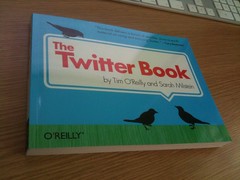
Google Buzz is the search engine giant’s latest attempt to get social to work within its suite of applications. Strangely, while we use Google’s stuff for all sorts of things, from searching to email to RSS aggregation to document editing, we don’t tend to use their services much for sharing. Instead, we go to Twitter, or maybe Facebook.
Perhaps all that will now change.
Here’s a video explaining Buzz and how it will work:
It may seem crazy to attempt to take Twitter on in its own territory, but Google have a couple of real strengths which mean they end up winning the status update battle.
For a start, Google have been quietly building up a range of services based on your Google account. You may have started this account to access Gmail, or maybe Google Reader.
But did you know you also have a public profile on Google, which you can fill up with all sorts of information about you and the sites and services you use? Here’s mine.
Or how about the way Google has a really cool service that manages all of your contacts?
What about the social circle search, which lets you look for content created by your friends, or friends of friends?
In some ways it’s kinda scary the way Google collects all this information, and the way it puts it all together like this. But it’s also a reason why Buzz might succeed where all other Twitter-killers have failed.
What’s one of the things that puts people off Twitter the first time they use it? The fact that you don’t know anyone, and have nobody to talk to. But the way Buzz will tap into your existing networks, you might not have that problem on Google’s service. The user base already exists, and it is already massive.
There is also masses of potential for organisations using Google Apps, where having Buzz as part of the mix will bring masses of value, and possibly kill off Yammer in the process.
There’s another reason why Buzz might well beat Twitter, and that is the money thing. Google has a business model, and a very successful one. It isn’t hard seeing how Buzz can slot into that model, and make a contribution. At some point, though, Twitter is going to have to start earning money. How it does that, and whether it manages to do so without annoying the hell out of its users – for whom revenue generation will necessitate a change – will determine whether Twitter survives.
Another thing that is in Buzz’s favour is that it sits inside Gmail. In your inbox. Despite the massive growth in social networking over the last few years, email is still the internet’s killer app, and most people spend a hell of a lot of time looking at their inboxes.
As an example of this, I use Google Talk a lot as an instant messaging service, but I use it entirely from within Gmail. I usually can’t be faffed loading up a separate client for IM, but if someone’s name pops up in Gmail saying they’re online, I’ll often grab them for a quick chat.
Having a status update, Twitter-like facility sat there too means that I’m going to use it, to the point where I might stop visiting other locations to do similar stuff. Bye, bye Twitter, maybe.
Of course lots of similar stuff was said about Wave, and while that wasn’t exactly a dud, it did strike me as a solution looking for a problem. A great bit of technology that felt a bit like a square peg. Buzz, though, isn’t looking to revolutionise the way we use the web, just to make an existing activity easier, and nearer – and that might be enough to make it work.
Having written all this, I of course don’t have access to Buzz yet. If you are one of the lucky ones, do please tell us all about it in the comments.
Update: Not sure how I missed it, but there is an API for Buzz, allowing for developers to hook it up to all sorts of other services, whether “Atom, AtomPub, Activity Streams, PubSubHubbub, OAuth, MediaRSS, Salmon, the Social Graph API, PortableContacts, WebFinger, and much, much more” according to the Google Social Web blog.
Elsewhere:
- Jeremiah has some useful insights
- Irwin Lazar thinks there’s a problem
- Dave Winer is not impressed (but then, when is he?!)
- MG Siegler sees Buzz as being FriendFeed on growth hormones
- Jeff Jarvis thinks Google is going for live, local and social with Buzz
- ReadWriteWeb also makes the Friendfeed comparison
- Louise Gray has some thoughtful analysis
- Jyri Engeström’s notes are worth reading – he founded Jaiku, a Twitter rival that was bought by Google
- Digg’s Kevin Rose has some feature requests already
Possibly related posts:
]]>Take a look at this story, excitingly titled on the BBC News site “Council Twitter users face rebuke“.
Councillors in Cornwall could face being reported to the authority’s standards committee for using social networking sites.
The trouble is, no they’re not.
Later in the article:
It follows claims that a number of councillors used Twitter during a meeting and mocked other members.
If a councillor is found to breach the code of conduct for inappropriate comments, they could be suspended.
So this is about councillors saying naughty things, and not about them using Twitter, or whatever.
Another example of the easy fixation on technology as being the story, when it isn’t. The story is behaviour: people and the relationships they have with others.
We really don’t need anymore Twitter scare stories, it isn’t productive and it helps nobody.
Possibly related posts:
]]>tweetwally is a terrifically simple site that lets you create your own pages that track what is being said on Twitter.
It’s a great way of sharing tweets on a topic with people who perhaps aren’t hardcore Twitter users.
I have set one up that tracks any tweets that have localgov in them. If anybody in local government wanted to demonstrate the use of Twitter in having conversations about local gov, they just need to load up the page, without having to mess about with searches, or lists, or whatever. It’s at http://localgov.tweetwally.com/.
Great work by Clockwork to produce a nice little site.
Hat tip to Matt Jukes for pointing it out.
Possibly related posts:
]]>Last week I spoke at the Online Information conference. It was a session about Twitter, where Karen Blakeman did a great job explaining the whole thing, and how organisations can make use of it. Then I stepped up and told a few jokes about government is – and should be – using Twitter.
Here’s the slides, for what they’re worth. Try and imagine a pillock gurning at you while you read them, it’ll provide some context.
Now, there is a thing here, and this is what it is: I don’t like doing tool-focused talks. One reason is that people get the impression that I am saying that everyone should be on Twitter, say.
To be swearily honest, I really couldn’t give a shit whether you use Twitter or not. I might write things that make it easier for you, but I would hate to feel like I’m making promises that it will change your life, or transform your organisation. It probably won’t. Things don’t tend to work that way.
I’m not trying to distance myself from Twitter, here. I still use it a hell of a lot, and my life would be poorer without it. The point I am making is true of any single technology, and goes back to the idea that, actually, the interesting things about the internet and its effect on society – and government – has nothing to do with computers.
Instead of encouraging people and organisations to use Twitter, or whatever, I want to encourage them to listen, to collaborate, to be transparent and open, to take notice of the things their employees say, to be flexible and agile and able to react quickly to changing circumstances.
Technology makes this easier. It provides a platform where it can all happen. In some cases it might be the key that unlocks the door to all this activity. But technology is not the thing.
Possibly related posts:
]]> You will all be delighted to know that I have written a handy quick-start guide to Twitter for people who work in and around government!
You will all be delighted to know that I have written a handy quick-start guide to Twitter for people who work in and around government!
I have had loads of requests for this, from people who can see that Twitter is taking off in a big way, but who also just can’t quite make their way around the service enough to make the most of it.
The guide takes absolute beginners to Twitter right from the start – explaining what Twitter is, and how to sign up – right through to replying, retweeting, hashtagging and using tools to measure success.
It’s free to download, just click the cover graphic or the text link below!
Download Learning Pool’s Twitter Guide
I’d love to know what you make of it, and if you have any suggestions for an updated version. Maybe you have an idea for another subject crying out for the Briggs treatment. Drop me your comments using [email protected] or send them via Twitter to @davebriggs.
And don’t forget, you can follow Learning Pool on Twitter too – @learningpool.
Possibly related posts:
]]>Neville writes a post about Twitter lists, some new functionality recently released to users. An official blog post trailed it last month.

Neville’s quite positive about it, and indeed it may well work for a lot of people. My view is more… meh.
If you follow lots of people it’s true that it is hard to keep up with everything that is said. I follow just under 1,500 accounts and reading everything is impossible. So I don’t.
TweetDeck, my desktop Twitter client of choice, has had groups – the ability to track a group of twitterers in a single, separate stream – for ages, and I’ve never used it.
After all, Twitter isn’t email. You don’t have to read it all.
I’m happy to dip in and out of my Twitter stream as I have time, and as I have something to say.
Anything that is directly pointed for my attention – ie by including @davebriggs in the tweet – is already highlighted for me. Likewise with the issues I am interested in – I monitor various keywords for mentions of those.
But other than that, I’m comfortable with the fact that I’ll miss the occasional gem – but know that if it’s really good, I’ll pick up on it later, anyway. The thought of spending a load of time managing a bunch of extra lists doesn’t really do it for me, at all – just as I don’t tend to put feeds in folders in Google Reader.
I guess I’m happy to rely on serendipity over organisation.
Possibly related posts:
]]>This is a lovely little guide to getting to grips with Twitter:
Thoroughly recommended.
Possibly related posts:
]]>Accessible Twitter takes Twitter and makes it more, er, accessible.
Excellent work!
Thanks to @littlelaura for the tip.
Possibly related posts:
]]>I’ve just found out that my sister is on Twitter.
Do say hello to her – I’m sure that as a press officer for a big charity, she’d love to hear how they can be using Twitter and other services to engage people in their stuff.
Possibly related posts:
]]>Marvelous explanatory presentation by Paul Bradshaw about Twitter – share it with the unbelievers!












